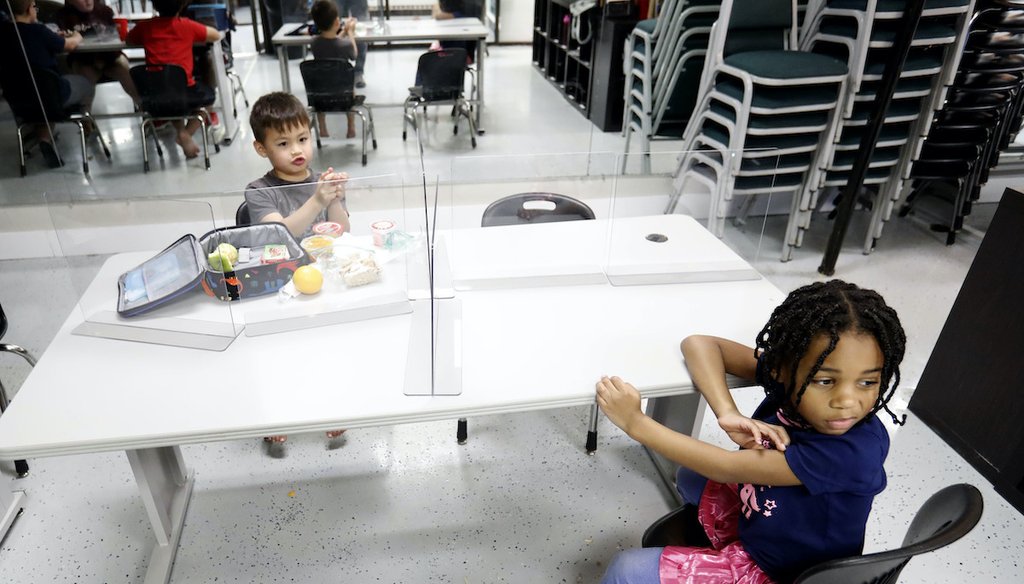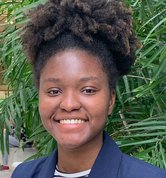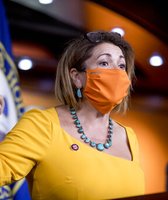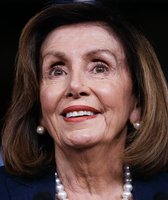Get PolitiFact in your inbox.

Plastic barriers are placed between children as they sit at a table during martial arts daycare summer camp at Legendary Blackbelt Academy in Richardson, Texas on May 19, 2020. (Associated Press)
If Your Time is short
-
Children make up a small percentage of confirmed COVID-19 cases and deaths.
-
There’s a lot researchers don’t know about childrens’ role in transmitting the disease.
-
It’s hard to know to what extent the virus affects children because they're often asymptomatic and don’t get tested.
Mid-to-late July is usually a time when American families gear up for a new school year. It’s filled with back-to-school sales, supply lists and a return to the structure an eight-hour school day provides.
But as the U.S. grapples with escalating confirmed daily cases of COVID-19, parents, teachers and lawmakers are wrestling instead with questions about how vulnerable children are to the coronavirus and what role they play in its spread.
Compounding these worries, health officials in some states are reporting outbreaks in camps and daycare facilities, including in Missouri, Texas and Maryland, prompting fear of the unknown to ripple through discussions of how and when to safely reopen schools.
RELATED: Key questions for reopening schools under COVID-19
To answer questions about children and the pandemic, we looked at recent data, reviewed medical studies and spoke with pediatric professors, infectious disease specialists and epidemiologists.
Medical experts we spoke with agree on one thing that’s been consistent throughout this pandemic: There’s still a lot we don’t know.
But what we do know so far is that children make up fewer confirmed cases, and tend to be less likely to develop complications. The rest, as they say, is still a bit of a mystery.
Children represent about 22% of the U.S. population, but only around 5% of confirmed COVID-19 cases, according to recent data from the Centers for Disease Control and Prevention. (That’s 1.7% of cases in the 0-9 age group and 3.8% of cases in the 10-19 age group). This holds true for other countries, too.
Dr. Megan Freeman, pediatric infectious disease fellow at UPMC Children’s Hospital of Pittsburgh, told PolitiFact that there are a couple of hypotheses for why children comprise a smaller proportion of infections. One is that they may not be getting tested as often because their symptoms are usually mild or absent.
"Another hypothesis is that children have less expression of the ACE2 protein that the virus uses as its receptor in their noses and lungs, making it more difficult for them to be infected," Freeman wrote in an email. "Children handle this infection very well, for the most part, with most having mild or absent symptoms. This is true for both younger children and teens."
The risk of infection is about the same between boys and girls, experts tell us. And while there are more confirmed COVID-19 cases among teenagers, hospitalization data hasn’t shown that their infections are more severe than those in younger children.
The CDC cites a report published in March as the largest pediatric study of patients with COVID-19 from China. The study, which assessed 2,143 patients, found that while child cases tend to be less severe than adult cases, young children and infants are vulnerable to the virus. Over 90% of the children had symptoms that were moderate, mild or nonexistent.
At a May 12 Senate hearing, Dr. Anthony Fauci said that he’s "very reserved in making broad predictions" about the impacts of the disease within the U.S.
"The more and more we learn, we’re seeing things about what this virus can do that we didn’t see from the studies in China or in Europe," Fauci said. "I think we better be careful if we are not cavalier in thinking that children are completely immune to the deleterious effects."When it comes to reopening schools, Dr. Sonja Rasumussen, a professor in the Departments of Pediatrics and Epidemiology at the University of Florida, said we need to be particularly concerned about children with underlying conditions such as diabetes, congenital heart disease, seizures and obesity.
"Those are the kids who are potentially more at risk," she told us.
The condition is rare, but it does affect otherwise healthy kids.
In May, doctors started to find that some children who previously had COVID-19 developed a rare condition called multisystem inflammatory syndrome.
This condition causes different parts of the body to become inflamed including the skin, heart, lungs and eyes, due to an over-productive immune response. Symptoms can include rash, bloodshot eyes, vomiting and abdominal pain. The majority of children recover, experts say, but it can be deadly. And, as has been the case with COVID-19, information about the syndrome and why it develops in some children and not in others is scarce.
Dr. Mark Schleiss, a professor of pediatrics at the University of Minnesota Medical School, said he’s concerned about the toll the syndrome might take on communities of color, which are disproportionately affected by the virus.
In a study of 186 pediatric patients with the inflammatory syndrome in the New England Journal of Medicine, 73% of the kids were previously healthy and many got pretty sick. The majority, 80%, needed intensive care, and 2% died.
"We still think it's a rare complication of COVID-19," Rasmussen said. "The hard thing is we don't have good information about how to predict who it might happen to."
Another paper examined 15,515 pediatric COVID-19 cases in New York State and found that 99 children exhibited symptoms of the syndrome.
Because patients were screened based on whether they were exhibiting symptoms, it's likely there were more COVID-19 infections than were detected. And that, Freeman said, would mean the rate of those who experienced multisystem inflammatory syndrome would have been even smaller.
Rasmussen acknowledged that the shutdown of schools in the spring was the best decision to keep kids safe, but it made it difficult for scientists to measure how they transmit the disease.
"Kids talk and sing and yell," she said. "They do things that spread viruses, and they have been shown to have a viral load when they test positive. So whether there's some reason they would spread less, I can't imagine what that would be."
Other medical experts told PolitiFact that the medical community doesn’t know yet whether it is less or more likely for children to spread the disease to one another, or for them to spread it to adults.
Schleiss said that children are "likely to play a critical role in transmission," based on studies of other diseases, but what we know about their role in transmitting COVID-19 is limited since the virus is new.
"There is not currently good data on how well children spread coronavirus infection compared to adults," Freeman said, noting that in the case of influenza, children are known to be the main spreaders of the disease in the community. But this isn’t necessarily true for COVID-19.
"We do not think that children are the main spreaders of coronavirus in the community, but they are capable of spread," she said. "There is not currently good data on how teens vs. younger children may differ biologically in their degree of spread, however, teens often have larger social groups than young children, are more mobile, and may not follow guidance about masking as well."
Schools and daycares being closed makes it hard to study transmission among children. And it’s easier to conduct studies with adults. So research on children will take more time.
"The kinds of things you can do with adults to understand it better, a lot of researchers will be more reluctant to do that in kids," Rasmussen said. "Sometimes we learn about kids later in an emergency response than we do in adults, especially in something like this where many kids are asymptomatic."
While it may feel like surefire answers have been hard to come by, scientists say the amount of data that has come out in such a short span of time is substantial.
"Especially when it's a new virus, people think you're changing your mind. But as we get more data, we change what we know," Rasmussen said. "Scientists are learning as fast as they can and are collecting information as fast as they can while trying to protect people at the same time."
"Science takes time, and good science takes even more time."
Our Sources
Centers for Disease Control and Prevention, Coronavirus Disease 2019 Case Surveillance — United States, January 22–May 30, 2020, Accessed July 9, 2020
Centers for Disease Control and Prevention, Frequently Asked Questions, Updated July 3, 2020
Centers for Disease Control and Prevention, Information for Pediatric Healthcare Providers, May 29, 2020
Pediatrics, Epidemiological Characteristics of 2143 Pediatric Patients With 2019 Coronavirus Disease in China, March 16, 2020
New England Journal of Medicine, Multisystem Inflammatory Syndrome in U.S. Children and Adolescents, June 29, 2020
Mayo Clinic, Multisystem inflammatory syndrome in children (MIS-C) and COVID-19, Accessed July 9, 2020
New York Times, How 132 Epidemiologists Are Deciding When to Send Their Children to School, June 12, 2020
Minnesota Department of Health, Situation Update for COVID-19, July 9, 2020
Phone interview with Mark Schleiss, professor of pediatrics at the University of Minnesota Medical School, July 9, 2020
Email interview, Dr. Megan Freeman Pediatric Infectious Diseases Fellow at UPMC Children’s Hospital of Pittsburgh, July 9, 2020
Phone interview, Dr. Sonja Rasmussen professor in the Departments of Pediatrics and Epidemiology at the University of Florida, July 9, 2020
Rev, Dr. Anthony Fauci & CDC Director Senate Testimony Transcript, May 12, 2020

































